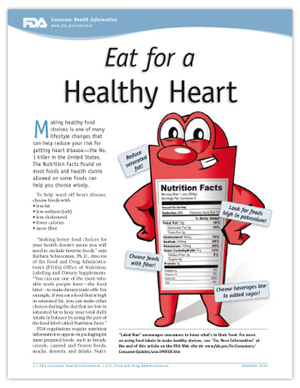Eat for a Healthy Heart
On this page
Making healthy food choices is one of many lifestyle changes that can help reduce your risk for getting heart disease—the No. 1 killer in the United States. The Nutrition Facts found on most foods and health claims allowed on some foods can help you choose wisely.
To help ward off heart disease, choose foods with
- less fat
- less sodium (salt)
- less cholesterol
- fewer calories
- more fiber
“Making better food choices for your health doesn’t mean you will need to exclude favorite foods,” says Barbara Schneeman, Ph.D., director of the Food and Drug Administration's (FDA's) Office of Nutrition, Labeling and Dietary Supplements. “You can use one of the most valuable tools people have—the food label—to make dietary trade-offs. For example, if you eat a food that is high in saturated fat, you can make other choices during the day that are low in saturated fat to keep your total daily intake in balance by using the part of the food label called Nutrition Facts.”
FDA regulations require nutrition information to appear on packaging for most prepared foods, such as breads, cereals, canned and frozen foods, snacks, desserts, and drinks. Nutrition labeling for raw produce (fruits and vegetables) and fish is voluntary.
Food Label and Nutrition Facts
“The food label gives people the power to compare foods quickly and easily so they can judge which products best fit into a heart-healthy diet or meet other dietary needs,” says Schneeman.
For example, people concerned about their blood pressure who want to limit how much salt (sodium) they eat may be faced with five different types of tomato soup on the shelf, says Schneeman. You can compare the sodium content of each product by looking at Nutrition Facts to choose the one with the lowest sodium content.
Nutrient Highs and Lows
Most of the nutrients that must be declared under Nutrition Facts on the food label are listed with a "percent Daily Value" (%DV), which shows the percent of the recommended daily intake that's in a serving of that product.
Consumers can use the %DVs to create a balanced diet. With a glance, they can see if a product has a high or low amount of a nutrient. The rule of thumb is 20% DV or more is high and 5% DV or less is low.
Health experts recommend keeping the intake of nutrients that may increase your risk for heart disease as low as possible. These nutrients are
- saturated fat
- trans fat
- cholesterol
There is no %DV for trans fat, but you can use the label to find out whether the saturated fat and cholesterol are high or low. When comparing products, look at the total amount of saturated fat plus trans fat to find the one lowest in both of these types of fat.
You can also use the %DV to choose products that contain higher amounts of heart-healthy nutrients, such as fiber. Eating fiber from fruits, vegetables, and grains may help lower your chances of getting heart disease.
Be sure to check the serving size on the Nutrition Facts part of the food label. If the serving size is 1 cup, and you eat 2 cups, you are eating double the calories and nutrients listed.
Health Claims
Some food products carry health claims—statements that the product may help reduce the risk of developing a certain disease or condition. FDA authorizes some health claims based on “significant scientific agreement,” which means that the claim is supported by strong, scientific evidence based on studies in people and that the claim is unlikely to be reversed by new studies. Only foods that meet the criteria for a claim are allowed to carry the claim on their labels.
Here are claims related to heart disease that you may see on some foods:
- While many factors affect heart disease, diets low in saturated fat and cholesterol may reduce the risk of this disease.
- Diets low in sodium may reduce the risk of high blood pressure, a disease associated with many factors.
- Soluble fiber from foods such as [name of food], as part of a diet low in saturated fat and cholesterol, may reduce the risk of heart disease.
Tips for Healthy Eating
- Choose lean meats and poultry. Bake it, broil it, or grill it.
- In a restaurant, opt for steamed, grilled, or broiled dishes instead of those that are fried or sautéed.
- Look for foods low in saturated fats, trans fats, and cholesterol. Most of the fats you eat should come from polyunsaturated and monounsaturated fats, such as those found in fish, nuts, and vegetable oils.
- Look for foods high in potassium (unless your health care professional has told you to restrict the amount of potassium you eat). Potassium counteracts some of the effects of salt on blood pressure.
- Choose foods and beverages low in added sugars. Read the ingredient list to make sure that added sugars are not one of the first few ingredients. (Ingredients are listed in descending order of weight. Those in the largest amounts are listed first.) Some names for added sugars include sucrose, glucose, high fructose corn syrup, corn syrup, maple syrup, and fructose.
- Pick foods that provide dietary fiber, like fruits, beans, vegetables, and whole grains.
This article appears on FDA's Consumer Updates page, which features the latest on all FDA-regulated products.
Date Posted: January 29, 2010
Return to FDA Consumer Articles

